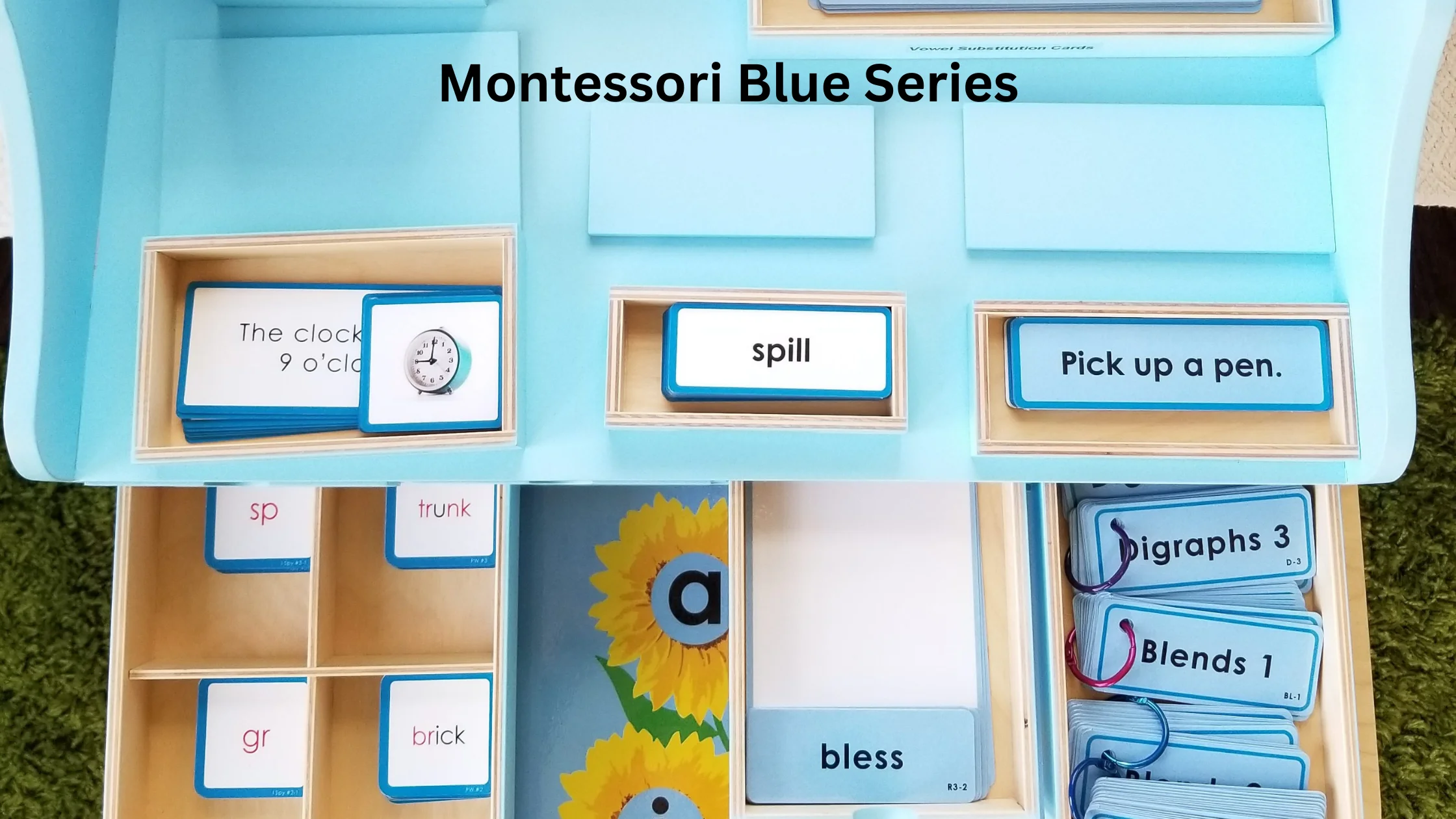When a child starts learning blocks then they make small blocks first. Then put those small blocks together to make bigger ones. The Montessori Blue Series is like that for words. After learning simple words, children start to build longer words using special sounds called blends.
It’s like a fun puzzle where kids learn to read and spell more tricky words. Now that we have understood the pink series, the beginning ones, we will go to the blue series, the bigger one. Let’s see how the Blue Series helps children become better readers.
What is the Blue Series in Montessori?
Imagine a world built with building blocks. The Blue Series works in a similar way. However instead of blocks, it uses letters. This series focuses on simple, three-letter words with the CVC pattern (consonant-vowel-consonant). Words like “cat,” “dog,” and “sun” are all part of this Blue series learning.
Why is the Blue Series Important?
The Blue Series is a special part of the Montessori reading program that helps children learn to read words with two sounds together. These sounds are called blends. It’s like putting two blocks together to make a new shape.
In the Blue Series, children learn to read words like “st”, “bl”, and “fr”. These are called blends because the two sounds stick together. However, the words included in the blue series vary from 4 to 5 letters in length.
What is the purpose of the Blue Series?
After learning simple words in the Pink Series, children are ready for a challenge. The Blue Series introduces them to word families and blends, which are groups of letters that make new sounds together. This helps children read longer words and understand how words are put together.
- Introduces children to more complex word structures
- Focuses on word families and consonant blends
- Helps children understand how words are formed
- Develops fluent reading and accurate spelling skills
- Prepares children for more challenging reading materials
- Bridges basic phonics to the complexities of English language
Using the Blue Series- A Guide for Parents and Teachers
The Blue Series is designed to bridge the gap between simple word recognition and the complexities of fluent reading. The Blue Series helps children become confident readers by building on their reading skills and teaching new language concepts.
#1: Consonants Blends
This component is pivotal in expanding children’s phonological awareness. By introducing consonant combinations such as “bl,” “st,” and “fr,” the Blue Series helps children understand that multiple sounds can be represented by consecutive letters. This knowledge is crucial for decoding unfamiliar words and building a robust phonics foundation.
- Expanding Reading Vocabulary- By learning consonant blends, children can decode a significantly wider range of words. This opens up new reading possibilities and enhances their comprehension.
- Building Phonological Awareness- Recognizing and blending consonant sounds helps children develop a strong foundation in phonological awareness. This skill is essential for accurate and fluent reading.
- Preparing for More Complex Texts- As children progress to higher levels, they will encounter more complex words with multiple consonant blends. A strong understanding of these blends lays the groundwork for tackling these challenges.
- Enhancing Spelling Skills- Learning consonant blends also benefits spelling. Children can apply their knowledge of these combinations to correctly spell words.
#2: Word Families
Focusing on groups of words sharing the same ending sound, like “-at,” “-it,” and “-ot,” the Blue Series reinforces pattern recognition. This component enhances children’s ability to analyse word structure, predict word endings, and generalise their reading skills.
- Pattern Recognition- By focusing on word families, children begin to recognize patterns in words. This helps them to decode new words more efficiently. For instance, once a child learns the “at” family, they can easily read words like “mat” and “pat”.
- Decoding Skills- Understanding word families strengthens a child’s decoding skills. They learn to break down words into smaller parts (onset and rime) and then blend them together to read.
- Spelling- Word families also help children with spelling. By understanding the pattern of a word family, they can more easily spell new words that follow the same pattern.
- Building Fluency- Recognizing word families contributes to building reading fluency. As children encounter more words from the same family, they become more familiar with the patterns and can read them more quickly and accurately.
#3: Object Boxes and Picture Cards
These familiar materials are adapted to the Blue Series level, featuring words incorporating blends and word families. Children continue to match objects or pictures to corresponding word cards, reinforcing vocabulary development and visual-auditory connections.
- Concrete to Abstract Connection- By linking physical objects or images with their written representation, children can better grasp the concept of words as symbols for things.
- Vocabulary Enrichment: The object and picture cards familiarize children with words, hence enriching their vocabulary.
- Phonics Reinforcement: The words on the cards often include consonant blends, thus reinforcing the phonics skills learned in the Blue Series.
- Sensory Experience: Handling the objects and seeing through the pictures provides a multi-sensory experience to learning, which improves memory and retention.
- Independence and Control of Error- Children can independently match objects or pictures to words, developing self-correction skills.
- Preparation for Reading- These materials lay the foundation for more complex reading tasks by strengthening word recognition and vocabulary
#4: Sentence Building
As children become more proficient in reading individual words, the Blue Series introduces sentence construction. By creating simple sentences, children develop an understanding of syntax, grammar, and the meaning-making process. This is done by arranging word cards in a logical order to form meaningful statements.
- Develops language comprehension- Children begin to understand how words work together to convey ideas.
- Enhances vocabulary- As children experiment with different word combinations, their vocabulary expands.
- Builds grammar foundation- Through sentence building, children naturally learn about sentence structure and word order.
- Fosters creativity- Children can express their thoughts and ideas freely through sentence construction.
- Prepares for reading comprehension- Understanding how sentences are formed is crucial for comprehending written text.
#5: Control Cards
These cards provide a systematic sequence for introducing new words and concepts. By following the control cards, guides can ensure that children are presented with appropriate challenges and build upon their existing knowledge.
- Systematic Presentation- Control cards guarantee a structured learning path, preventing gaps in knowledge and ensuring that children build upon previously learned concepts.
- Independence- By following the visual cues on the control cards, children can work independently, fostering self-directed learning and problem-solving skills.
- Clarity and Focus- Control cards provide clear instructions for both teachers and children, minimising confusion and maximising learning efficiency.
- Individual Pace- As children progress at different rates, control cards allow for individualised learning experiences, ensuring that each child is challenged appropriately.
- Curriculum Alignment- Control cards ensure that the Blue Series curriculum is implemented consistently across different classrooms and settings
Activities to Make Learning Fun
Learning should be an adventure! Here are some engaging activities to make the Blue Series more fun.
- Playdough Blends- Create playdough with different colours and let children mould shapes that start with different blend sounds.
- Sandpaper Letter Hunt- Hide sandpaper letters with blend sounds in a sensory bin filled with rice or beans. Children can hunt for them and practise sounding them out.
- Blend Bingo- Create a bingo card with pictures and words containing different blends. Call out blends and have children cover the matching picture or word.
- Word Family Card Game- Create cards with word families and blend cards. Children match the correct blend to the word family to form new words.
- Blends Charades- Act out words with blends, and have children guess the word
- Blend Scavenger Hunt- Hide objects around the yard or park that start with different blends. Children can search for them and practice saying the blend.
- Nature Blends- Take a walk and find objects in nature that start with different blends. Collect leaves, stones, or flowers and create a nature collage
- Blend Stories- Create simple stories using words with blends. Children can read the stories and practice sounding out the words.
- Blend Writing- Provide writing prompts that encourage children to use words with blends in their writing
- Blend Art- Encourage children to create art pieces inspired by words with blends. For example, draw a picture of a blue bird for the blend “bl”
Final Thoughts
The Montessori Blue Series is much more than just one more step in the learning process; it is the gateway to a world of words. That’s what the Blue Series does: introducing children to the fascinating world of blends and word families, hence sparking curiosity and discovery.
It’s more than learning to read; it’s laying a strong foundation for lifelong learning. Remember, every child is different, so celebrate their own progress. Only with patience, encouragement, and a dash of creativity can the Blue Series transform your child into a confident and keen reader.

